Last updated on March 7th, 2025
Draining a central heating system can be difficult and take a long time, but it is sometimes necessary to replace radiators and perform other heating jobs. Knowing how to drain a radiator system (and refill it) can save you money and give you the skills to flush a central heating system. I have been a full-time heating engineer for over a decade and have drained and flushed many heating systems.
Video guide
Step-by-step guide
A central heating system should have at least one drain-off valve but not all do. If you don’t have one, you should get one fitted.
If you have a vented gravity heating system, you must turn the water off at the stopcock first.
How to drain the system:
- Connect a hose to a drain-off valve with a hose clip
- Run the hose to a drain outside
- Open the drain-off valve with an adjustable spanner
- Look for water coming out of the hose and going down the drain
- Wait for the water to stop coming out
- Vent (open) the bleed valves on all radiators on the highest floor
- Wait for the water to stop coming out of the hose outside
- Vent the radiators on the next floor down
- Wait for water to stop coming out of the hose
- Repeat until all radiators on all floors are drained
- Close the bleed valve screws and drain-off
Sometimes radiators on the ground floor will have their pipes going straight upstairs, typically because they have a concrete floor, These radiators won’t drain from a central drain-off valve. They will need to be drained individually.
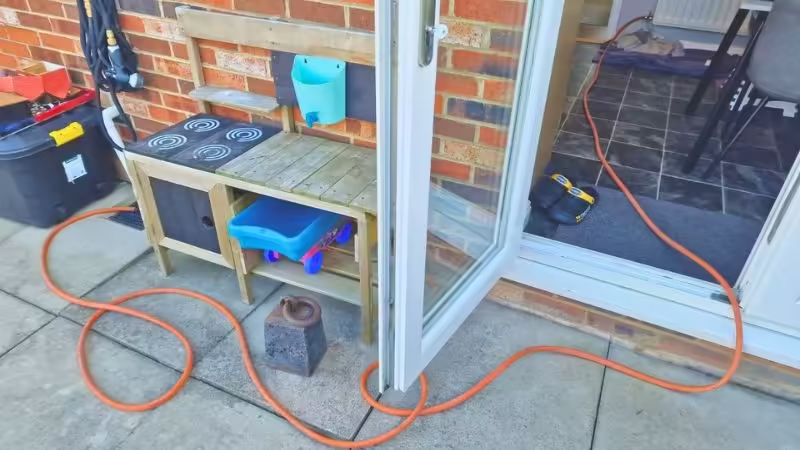
Draining without a drain valve
Draining a central heating system without a drain valve is sometimes needed. Most combi boilers have a drain-off valve on the bottom which you can drain the system from, but you won’t be able to drain any radiators that are below the boiler from here.
On a vented gravity heating system, the feed and expansion tank (typically in the loft) can be bunged using central heating rubber bungs.
After draining the system, you should replace a radiator valve with a radiator drain-off valve for future draining.
Three ways to drain a system without a drain-off valve:
- Drain from a radiator valve
- Use a self-cutting drain-off valve
- Cut a heating pipe under the floor
Drain from a radiator valve
My preferred way to drain a system without a drain-off valve is to isolate and plug the radiator and then drain the system from the valve. This can be from a TRV or lockshield. You will need a 15mm nut, olive, and a small piece of copper pipe. You might need a 3/4″ nut and tail that come with new radiator valves also.
How to isolate a radiator to drain the system:
- Find the lowest radiator downstairs
- Put some towels down under the radiator valve
- Close both radiator valves
- Crack the side nut on the valve
- Wait until the water stops coming out
- Crack the nut on the bottom of the valve to loosen it slightly
- Unscrew the side nut fully and pull the valve away
- Twist the valve towards you
- Fit a blank plug to the radiator nut to keep the water in
- Connect the small copper pipe to the radiator valve
- Connect a long hose to the pipe and run it to the drain outside
- Open the valve and follow the steps above to drain the system
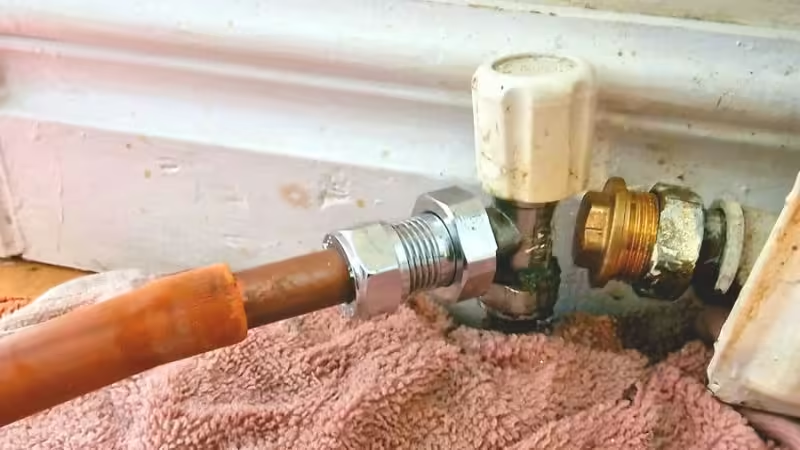
Self-cutting drain-off valve
You can also use a self-cutting drain-off valve to drain a heating system.
Here’s how:
- Find the lowest radiator pipe (at least 15mm)
- Connect the self-cutting drain valve clamp to the pipe and tighten it with a screwdriver
- Screw in the brass valve with your hand then with some water pump pliers
- Connect a drain down hose and run it to a drain
- Open the drain-off valve and follow the steps above to drain the system
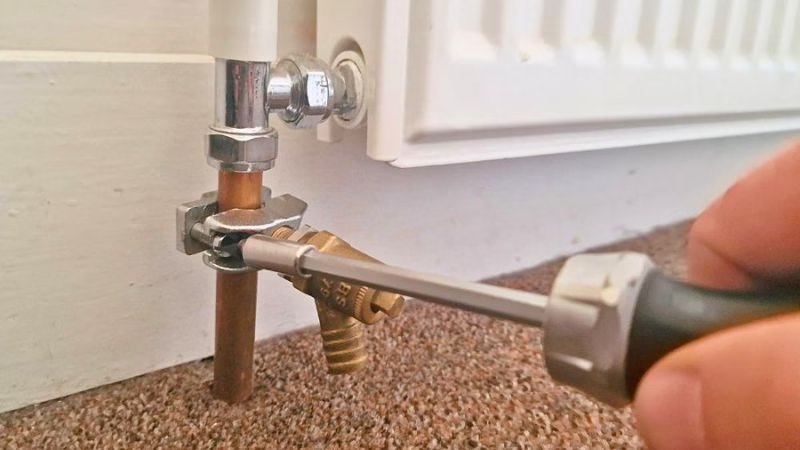
Cutting a pipe under the floor
Sometimes cutting a pipe under the floor is needed to let the water out and onto the ground downstairs, just make sure there are no electric cables that could get soaked with the water.
You can use a push fit or compression coupler to connect the cut pipe again after you’ve finished draining the system.
- Pull up a floorboard and locate a heating pipe
- Cut the pipe slowly with a pipe slice cutter
- Stop cutting as soon as the water starts coming out
- Keep the pipe cutter and your hand on the pipe to stop any water from spraying everywhere
- Wait for the water to stop coming
- Cut the pipe fully and remove the pipe cutter
- Follow the steps above to drain the system
Fit at least one drain-off valve when the system is drained so you won’t need to cut the pipe again in the future.
How to drain a radiator
Draining a radiator is sometimes useful for adding inhibitor and other chemicals, replacing the radiator, or accessing the valve properly for draining the system.
Draining a radiator can take a long time and get messy sometimes. Typically, the bigger and older the radiator the worse it is, and the smaller and newer the better.
Here’s how to drain a radiator:
- Put some towels down under the radiator valves
- Close both radiator valves
- Place a Plumb Tub under one of the radiator valves
- Open the bleed valve screw and catch the water
- Wait until the water stops coming out
- Crack the side nut on the valve
- Make sure the bleed screw is still open
- Let the water drain into the Plumb Tub
- Tighten the nut when the tub is full
- Empty the tub
- Repeat the process until the radiator is empty
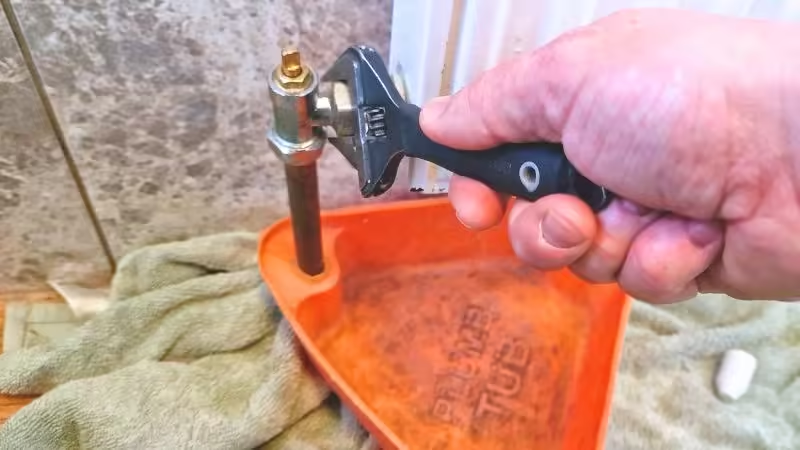
How to refill the system
Before refilling the heating system, ensure all the radiator bleed valves and drain-off valves are closed.
Gravity-fed systems
Vented gravity systems will take a lot longer to refill than a pressurised system.
- Turn the water supply back on
- Leave it for half an hour or so to let the tank in the loft fill up with water
- Bleed all the radiators starting with the lowest first
If the air stops coming out when you are bleeding the radiators, leave it for a while until the tank in the loft is full, giving you more pressure. Follow the instructions below for how to bleed the radiators correctly.
Pressurised systems
To refill your pressurised heating system you must repressurise the boiler via the filling loop. This is usually under the boiler on a combi boiler, or in the cylinder cupboard if you have a system or conventional boiler.
- Open the filling loop valves until you get to 1.5 bar on the pressure gauge
- Bleed the radiators starting with the lowest radiators first
- Hold a towel under the radiator bleed valve
- Turn the bleed valve screw anti-clockwise with a bleed key
- Close the bleed screw when the water starts coming out
- Keep repressurising the boiler when the pressure drops
- Bleed all the radiators on the lowest floor
- Move onto the next floor and bleed all the radiators
- Keep repressurising and bleeding radiators until all radiators are bled
You should always bleed the lowest radiators first. If you bleed upstairs first, the water will come down from the upstairs radiators when you bleed the lower radiators.
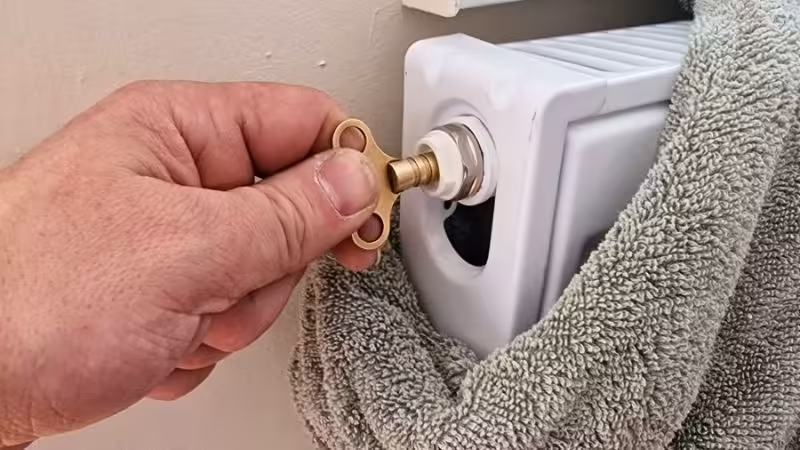
Radiator not heating up
After draining and refilling a heating system, you can get trapped air causing an airlock in the pipes. This can cause radiators to not get hot or sometimes the boiler not to fire up. You need to get rid of this air by bleeding it out. This can take all day (on certain systems) and be very frustrating.
How to clear an airlock
Here’s how I clear an airlock in radiator pipes when a radiator is not heating up:
- Turn the heating on
- Close one valve on every hot radiator
- Wait for the airlocked radiator(s) to get hot
- Bleed the radiator
- Open all the radiator valves
Boiler not firing up
If the boiler is not firing up or keeps cutting out, you need to get the air out which can take all day sometimes.
Here’s what I do:
- Turn the heating on
- Bleed the radiators
- Bleed the bleed valve in the cylinder cupboard
- Bleed the central heating pump
- Reset the boiler
- Repeat, repeat, repeat until the boiler stays fired up
Summary
Draining and filling a central heating system can be a very hard job, even for full-time heating engineers, especially on old or large heating systems. Lots of problems can pop up along the way and overcoming them can be very frustrating.
Feel free to ask any questions in the comments below, and I’ll do my best to help. If you found this post helpful, please consider sharing it.
FAQs
Do you need to turn the water off to drain a central heating system?
You only need to turn the water off to drain a central heating system if you have a gravity-fed system with a conventional boiler. With pressurised systems (combi boilers and system boilers), you do not need to turn the water off.
How long does it take to drain a central heating system?
The time it takes to drain a central heating system depends on the system size, layout, and condition. It can take anywhere from 20 minutes to a few hours or more. It will be a lot quicker if you have a drain-off valve (one that actually works).
Where is the drain valve on a central heating system?
The most common place to find a drain valve is on a radiator valve downstairs. It could also be anywhere on the heating pipes, sometimes under the boiler or a radiator. Some boilers have drain valves on them. Not all central heating systems have a drain valve.
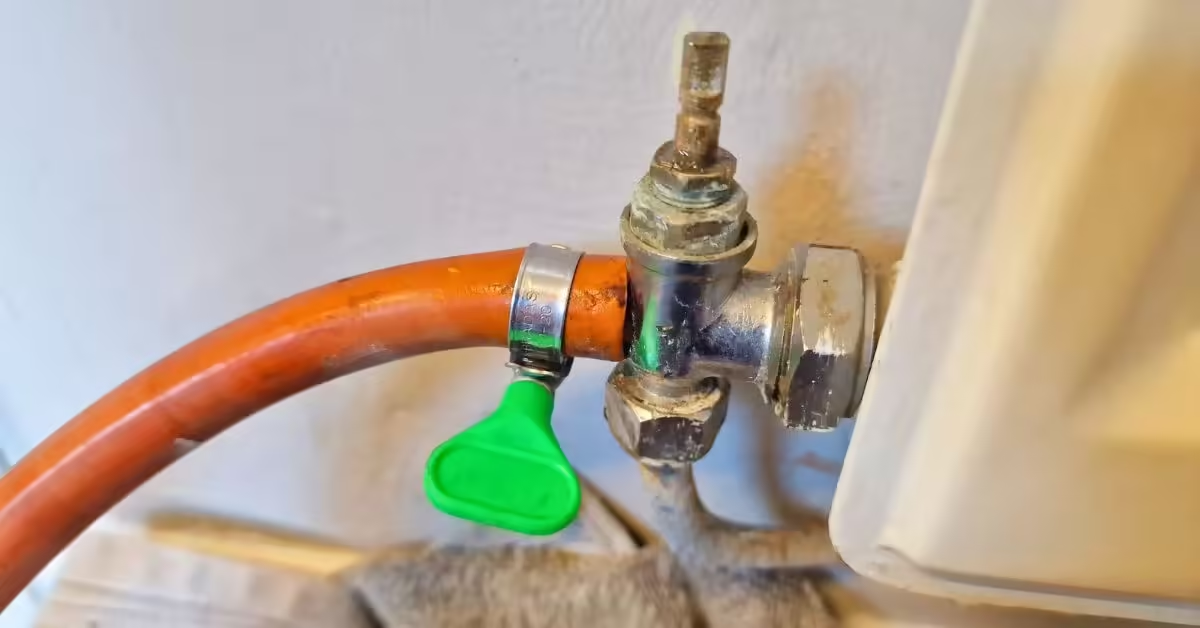

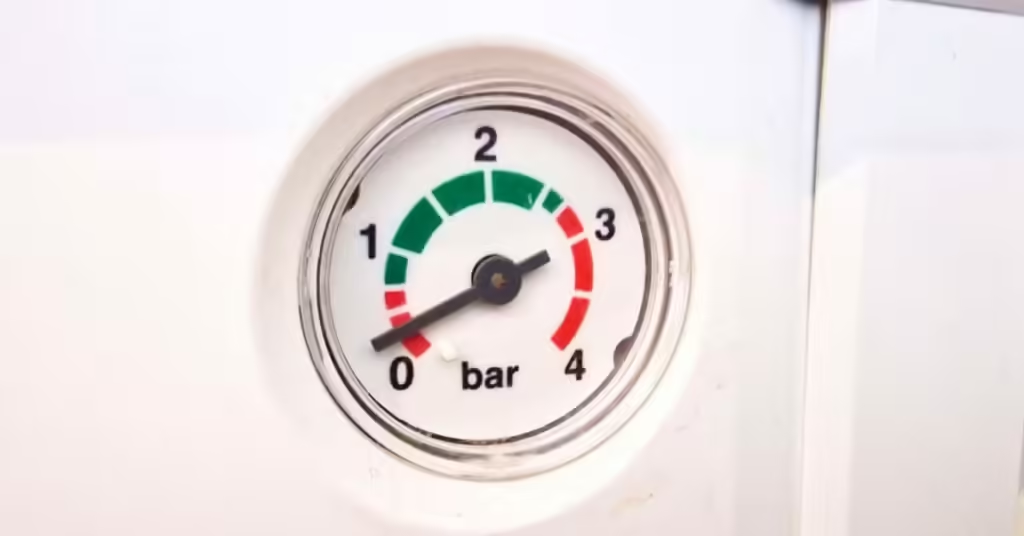
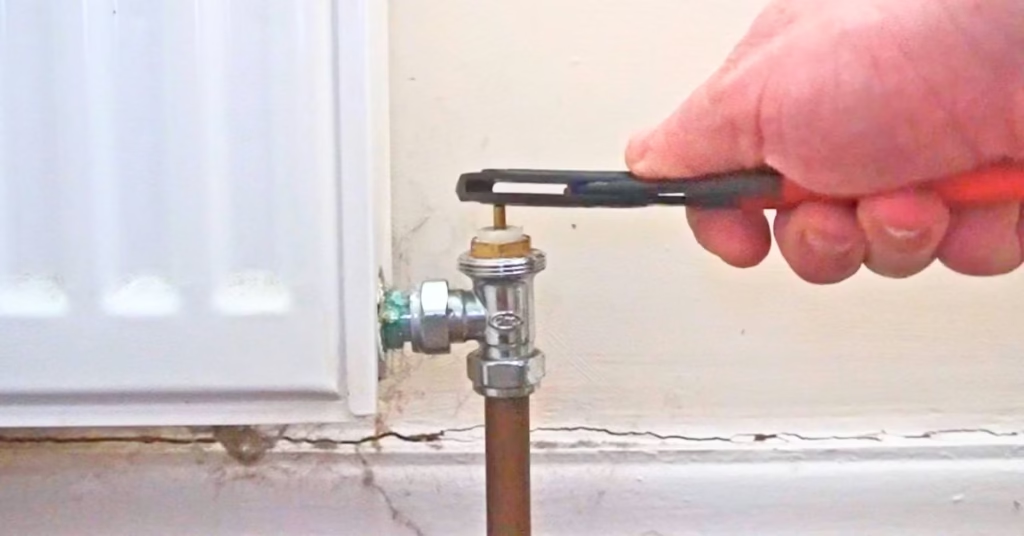
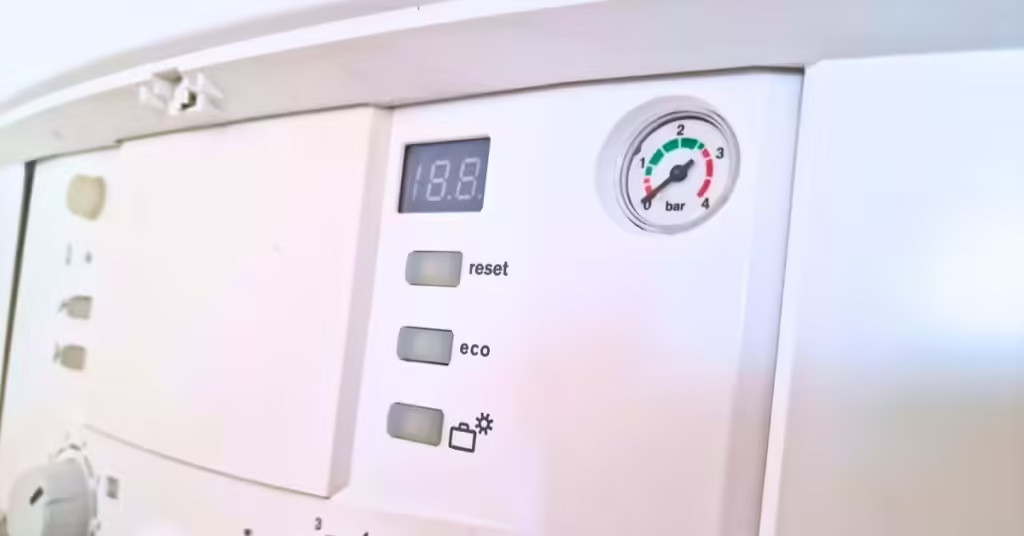
Hi, i have removed my rad and need to drain the system to remove another radiator. When i open the valves for the removed radiator to drain the system no water comes out. Can you advise
Hi Eamonn, try venting the radiators (highest first) by opening the bleed valve with a bleed key.
Hello Steve,
Thanks for posting your instructions.
I’m about to partially drain a pressurised system (moving an upstairs rad), then refil. Do I need to worry about the Zilmet expansion tank when doing this or will that look after itself during the process.
Cheers, Rob
Hi Rob,
You don’t need to worry about the expansion vessel, it’s pressurised internally and won’t be affected by draining or refilling the heating system.
Hello Steve
I wonder if you could advise me about having a new combi gas
boiler installed. I got several quotes and the best value one was from a one man outfit . I am worried now as to whether it includes a power flush or is this essential for a new installation ? There are 7 radiators and the quote is for a 30 kw Glow worm boiler . I would be grateful for your expert advice .
Marion Howard
Lymington.
Hi Marion,
Yes, the heating system needs to be flushed after fitting the new boiler for warranty, boiler manufacturers require it. It doesn’t have to be a power flush, just a system flush where you add a chemical cleaner to the system and fire the heating up for a while then drain the system and refill it with clean water and inhibitor.
Brilliant write ups. I’ve got water coming out of my boiler expansion vessel and I have to top it up weekly as loses pressure. My plumber was round the other day doing an unrelated job and I told him about the weekly top ups (not the vessel issue as hadn’t discovered that at that point) and he said that’s normal in the winter. On reading your blog it’s explained the components and u now realise I have a split diaphragm. Have ordered the vessel and prv and doing it this weekend. Going to put Fernox inhibitor in too as must be so diluted by the top ups. This was another thing that my plumber said wouldn’t need doing as it’s so concentrated it would still be working?! Thanks for your site and advice.
Rob in Ringwood
Thanks Rob, appreciate the kind words.
Yes, keep topping the pressure up will be diluting the inhibitor, by how much varies greatly. You would have to test it with an inhibitor test kit to know for sure but I would definitely recommend adding a bottle of inhibitor to the system when you have fixed the problems.
Steven,
I have to replace leaking drain cock next to cylinder on top floor of 3 storey house – can I therefore get away with only draining the top floor? Many thanks Brad
Hi Brad,
Yes, if it’s a drain valve for the heating then yes you can just drain the top floor.